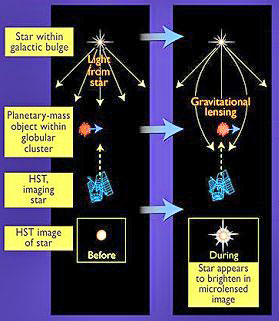
|
|
 |
|
June 29, 2001 -- Astronomers using NASA's Hubble Space Telescope have spotted something extraordinary. Apparently there are planet-sized objects wandering through a distant globular cluster of stars. Unlike the planets in our own solar system, however, these objects are loners -- they have no central star of their own. Because the findings are so surprising, researchers caution that they must be confirmed by follow-up observations. But if this discovery is verified, it could change the way astronomers think about stars and planets, and how the two are related.  Above: This stylized view shows Hubble peering through globular cluster M22 in search of microlensing "flares" from background stars. Credit: Zolt Levay (STScI) [more] The unusual objects in question are too dim to be seen directly, even by Hubble. Instead they were detected by the way their gravitational field bends and amplifies light from distant background stars, a technique called "microlensing." From February 22nd to June 15th, 1999, Kailash Sahu (Space Telescope Science Institute) and colleagues monitored 83,000 stars in parts of our Galaxy lying behind the globular cluster M22. They detected one clear microlensing event caused by a normal dwarf star -- a star in M22 about one tenth the mass of our Sun. The dwarf star's gravitational field focused the light from the background star, causing it to appear 10 times brighter before it returned to normal over a period of 18 days.
Right: A schematic diagram of microlensing. Click to enlarge. Credit: Ann Field (STScI) These microlensing events were unusually brief, indicating that the mass of the intervening object could be as little as 80 times that of Earth. Objects this small have never before been detected by microlensing observations. If these results are confirmed by follow-up Hubble observations, the bodies would be the smallest celestial objects ever seen that are not orbiting a star. So what are they? Theoretically, planets can be gravitationally torn from their parent stars in the cluster to form a population of wanderers. But, say researchers, that explanation won't work. The planet-sized mystery bodies in M22 could make up as much as 10 percent of the cluster's mass. They are too numerous to have once been parts of normal planetary systems. What's next? More observations!
When a background star is microlensed, it brightens and dims for a length of time depending on the mass, distance, and velocity of the intervening lens. Because lensing objects in M22 are all part of the same cluster, the astronomers know their distance (8,500 light-years) and their approximate velocity. As a result, it's possible to estimate the mass of such lenses from the light curve of the background star. The six brief events Sahu's team detected were even shorter than the interval between the Hubble observations, so in practice they could only estimate a limit on the mass of the lenses. The lenses could be as lightweight as one quarter the mass of the planet Jupiter -- a sensational finding!
To confirm these extraordinary, but tentative results, Sahu and colleagues next plan to monitor the center of the globular cluster continuously over a seven-day interval. They expect to detect 10 to 25 short-duration microlensing events, which will be well-sampled enough to yield direct measurements of the true masses of the small bodies, perhaps confirming their planetary character. The modern word "planet" comes from a Greek root that means "wanderer," so named by ancient astronomers who watched the worlds of our solar system move among the stars in the night sky. But our planets are not true nomads, they obediently circle the Sun. The mystery objects of M22, however, appear to be genuine wanderers -- plying their own course in a distant sea of stars. Will they eventually lay claim to the title "planets?" Only time -- and lots more data -- will tell. Sahu and colleagues published their results in this week's issue of Nature. The Space Telescope Science Institute, Baltimore, Md., manages space operations for the Hubble Space Telescope for NASA's Office of Space Science, Washington, D.C. The Hubble Space Telescope is a project of international cooperation between NASA and the European Space Agency. |

